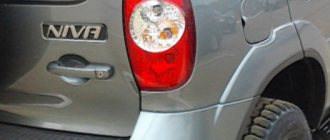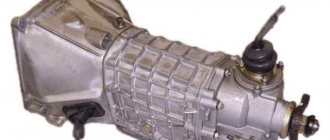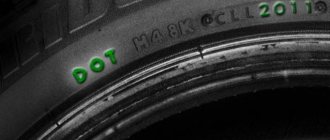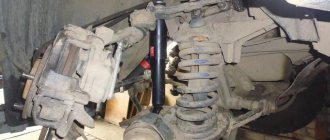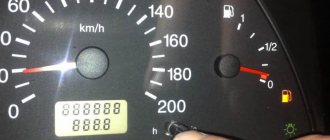Gas tank characteristics
All Chevrolet Niva, regardless of generation and year of manufacture, are equipped with tanks of the same capacity and shape. The gas tank is made of sheet steel connected by welding. This material has its positive and negative qualities.
Advantages of a steel tank:
- High strength.
- Possibility of repair for minor damage.
- Safety.
There are only two disadvantages to the Chevrolet Niva tank:
- A gas tank cannot be repaired if it has severe dents or large holes.
- Rust forms inside the container, which must not enter the fuel system. Therefore, the tank needs periodic cleaning.
The tank has a flat shape and is located under the body at the bottom of the car.
It has a driveshaft stamping that divides the gas tank into two partially communicating tanks. As a result, a remainder of 5-6 liters of gasoline is formed, which cannot be used.
The volume of the gas tank is 58 liters. This is enough to travel 400-600 kilometers on one gas station.
The part number is GENERAL MOTORS 212301101011000, but more often you can find gas tanks manufactured by AvtoVAZ. With acceptable quality, they cost from 8,000 rubles.
Can the tank hold more gasoline?
The capacity of the gas tank is indicated by the manufacturer without taking into account the possibility of filling fuel under the neck. Therefore, if desired, it can hold up to 63 liters . To do this, after shutting off, you need to lift the gun above the filler neck and continue refueling. The main thing is to do this in such a way as not to spill gasoline.
Unlike gas, filling up with liquid fuel is not fraught with danger. When heated, gasoline almost does not expand, and excess pressure is compensated through a vapor removal tube connected to the adsorber.
Video about the problem of the Chevy Niva gas tank
Chevrolet Niva is a serial all-wheel drive off-road vehicle produced by the Volzhsky Automobile Plant. Drive to all four wheels is permanent, all-wheel drive. The Niva is equipped with a two-speed transfer gearbox and a locking differential, allowing it to overcome inclines of up to 35 degrees.
The Chevrolet also performs well off-road and is able to navigate difficult areas in any weather. The car became the heir to the Niva VAZ 2121, which during its time gained popularity not only in the vast expanses of the former Soviet Union, but also abroad. The new brainchild of AvtoVAZ Chevrolet Niva specialists embodies the advantages and advantages of the previous model, supported by the introduction of new production technologies.
The Chevrolet has a VAZ-2123 four-cylinder in-line petrol engine with a displacement of 1700 cm³, a distributed fuel injection system. The engine provides power to the Chevrolet Niva up to 80 hp. (59 kW) with a torque of 128 Nm.
Modification of Niva Chevrolet
Since the end of 2006, Chevrolet Niva FAM1 cars began to roll off the AvtoVAZ assembly line. The car had an Opel engine with a volume of 1800 cm³ and allowed it to develop a power of 122 hp. This Niva model was equipped with a 5-speed manual transmission, a new transfer case, made in the same unit with the gearbox. This model had a richer package:
- ABS system, providing an increased degree of safety when braking;
- increased diameter vacuum brake booster (10 inches);
- drive joint shafts;
- Interior air conditioning, providing additional comfort for passengers and driver;
- two front airbags, which significantly increased the car’s safety performance;
- front seats adjustable in three planes;
- Pre-action seat belt tensioners.
Available modifications
In 2006, AvtoVAZ launched into mass production a new generation of NIVA Chevrolet, which used a more powerful power unit from Opel, in tandem with which the engineers decided to install a five-speed transfer-type manual transmission. This combination made it possible to significantly increase the power and dynamic characteristics of the SUV.
The electronic equipment of the car has also undergone significant changes. The vehicle has become more modern, comfortable and safe. The brake system is equipped with an anti-lock braking system, and the discs are equipped with ten-inch vacuum brake boosters. To increase the reliability of protection and safety of life of the driver and front passenger, the developers equipped the SUV with two modern airbags. An active air conditioning system has been installed in the car interior, providing an optimal interior microclimate. A pleasant surprise was the presence in the updated NIVA Chevrolet line of passenger seats with pneumatic drive, which allows you to adjust the level of inclination and height, which significantly increases the level of comfort.
The SUV leaves the assembly line in a two-volume body, the characteristic feature of which is a slightly reduced interior space in favor of the luggage compartment. To increase the efficiency of using usable space, the fuel tank was located under the bottom of the car, and was also made in a form with a very complex design, which has a certain impact on the gasoline supply.
Volume of the tank
The rated volume of the Chevrolet Niva fuel tank is 58 liters. When a certain minimum level of gasoline is reached, the light begins to flash, after which it remains on continuously, which indicates a low fuel reserve in the tank.
It was experimentally established that the lamp lights up at 12 - 15 liters, since some experts claim that the Niva fuel tank has a large dead reserve. At the same time, 42-44 liters of gasoline were added to the gas station cutoff. That is, the conclusion suggests itself that the volume of the car’s tank reaches 61 liters.
Accordingly, the question arises - how much can a Niva fuel tank really hold, how much is left at the moment the lamp starts to light up, and how many liters will fit after the cutoff on the refueling nozzle?
To get an answer, you need to consider the following nuances and features:
- The fuel gauge on the dashboard is unable to accurately indicate the amount of gasoline because it is not a calibrated measuring device.
- The readings are significantly affected by the location of the car relative to the horizontal plane.
- Accordingly, the ambient temperature has some influence, contributing to a change in such a quantity as the volume of liquid.
Chevrolet Niva tank volume
The Chevrolet Niva is a small car that at first glance seems like an SUV. However, in reality it is a true off-roader, designed for real adventure. Its small size, short wheelbase, and permanent four-wheel drive allow it to get out of any swamp. In almost 20 years of its existence, the car has remained virtually unchanged. The only innovation that was once introduced by the manufacturer is a plastic body kit.
The history of the Chevrolet Niva car began in the last century, in 1998, when the VAZ 2123 “Niva” concept was first demonstrated to the public at the annual car show in the Russian capital. It was planned that the new product would replace the VAZ 2121 Niva model, which by that time had been produced without any changes for two decades.
But serial production of the VAZ 2123 began only some time later, after AvtoVAZ sold a production license to General Motors. However, before the start of sales, many changes were made to the appearance. The result was a car that no longer resembled the familiar and familiar Niva. Therefore, the new model could be considered completely independent. The debut of the new Niva from AvtoVAZ took place in 2002. They wanted to discontinue the previous version, but due to the high price of the new product, this was never done. In terms of cost, the car could easily compete with foreign SUVs. However, in terms of quality, unfortunately, VAZ was very far from them. After 7 years, an updated version of the Chevrolet Niva was born. Only the exterior and interior were restyled. However, the technical content has not changed.
Chevrolet Niva tank volume
The Chevrolet Niva car can be equipped with one of two engines: either a 1.8-liter from Opel, or a 1.7-liter from AvtoVAZ itself. The first to be equipped are those cars that are intended for export. And cars that are sold here in the CIS countries are equipped with an engine from AvtoVAZ. In both cases, the gas tank volume is 58 liters. It is clear that the Opel engine is much better, both in power and quality. Its productivity is 125 hp. With. It is a real exotic for residents of the CIS. Moreover, the 1.7-liter engine is almost two times weaker. Its power is only 80 hp. With. In addition, it has other serious shortcomings.
Firstly, the standard timing tensioner is not reliable, and therefore the chain often jumps. Secondly, the ignition module often fails. It needs to be changed when the dynamic performance deteriorates.
Thirdly, the radiator often begins to leak in the cooling system. The Chevrolet Niva 1.7 engine has four cylinders and can develop power up to 80 hp. With. The maximum speed to which a car can be accelerated is 140 km/h. It is impossible to find a motorist who would not worry about the fuel consumption of his “iron horse”. The fuel consumption indicator is always of great importance, since it determines the amount of money that will be spent on the purchase of gasoline. In order to determine how much fuel a car needs to cover a particular distance, you need to know the capacity of the fuel tank and the nature of the surface of the road on which the car will travel. Psychologically, the mark stands out - 10 liters per 100 km.
If less is consumed, then the engine efficiency is good. And if more, then explanations are required.
The tank volume of Chevrolet Niva cars is 58 liters. This indicator indicates that the cars belong to the middle class. Fuel consumption on average slightly exceeds the 10 liter mark. The technical data sheet for a Chevrolet Niva with a 1.7 engine contains the following data: when driving around the city, 14.1 liters of gasoline are consumed per hundred kilometers. When traveling on country roads, this figure decreases to 8.8 liters. And during mixed driving, the engine “eats” about 10.8 liters. The Chevrolet Niva 1.8 engine, made in Germany, when driving around the city, consumes a little more than 12 liters of fuel per hundred kilometers. When driving on a country road, consumption is less than 9 liters. In the combined cycle, this figure is slightly more than 10 liters.
Many owners of the Chevrolet Niva, as well as those who do not own this car, are convinced that the engine of this model is very voracious. Of course, one cannot help but be surprised that, according to official data, up to 14 liters of gasoline are consumed per 100 km.
Many, frightened by this figure, finally decide for themselves not to even approach this model in auto stores. However, it should be remembered that the Niva is an SUV. It has four-wheel drive and good stability on winter roads covered with snow. The second axle and transfer gearbox significantly make the car heavier. They load the engine. This is why fuel consumption also increases.
Features of fuel tank volume
Therefore, the light on the Chevrolet panel lights up at different levels of fuel in the tank. When filling to the cut-off point, the filler neck may be filled, which increases the volume of gasoline poured. In this case, the quantity also depends on the filling speed of the filling column.
The Niva fuel tank has a specific bottom geometry; it is partially divided in half by stamping made for the driveshaft channel. Therefore, the tank cavities are partially connected, which leads to the formation of a dead stock of 5-7 liters. When refueling at different stations, the volume of fuel added may fluctuate due to underfilling or different settings of the cut-off system on the refueling nozzle.
It is also necessary to take into account that the fuel sensor is installed on the right side of the tank in the same plane as the fuel take-off pipe and the filling neck; accordingly, the presence or absence of dead stock in the left cavity is not always taken into account.
If the car has a small amount of fuel and was moving on a rough road before refueling, then the amount of reserve in the left compartment may be minimal, while refueling at the cut-off point will reach up to 60 liters.
It is especially important to remember that in hot weather it is not advisable to fill the fuel tank to the limit, since it must contain a small reserve of volume to compensate for expansion and fuel vapor.
The Chevrolet Niva is a small car that at first glance seems like an SUV. However, in reality it is a true off-roader, designed for real adventure. Its small size, short wheelbase, and permanent four-wheel drive allow it to get out of any swamp. In almost 20 years of its existence, the car has remained virtually unchanged. The only innovation that was once introduced by the manufacturer is a plastic body kit.
What is the volume of the fuel tank of the Niva Chevrolet: technical parameters
Many car enthusiasts are confident that our automotive industry is in complete ruin and there are almost no companies left producing decent equipment. This is a misconception, and domestic designers can rarely surprise you with a worthy product. One of the results of fruitful work is the all-wheel drive Niva Chevrolet. The main feature thanks to which the car has conquered the domestic market is its increased cross-country ability.
Chevrolet Niva has collected all the best features of previous models, supplemented by some new technologies.
This model is powered by a four-cylinder in-line petrol engine with a displacement of 1,700 cc. cm. The engine provides the car with power up to 80 hp. With. with a torque of 128 Nm.
Car modification
Since 2006, the plant began producing the Niva Chevrolet FAM 1. The car received an engine with a capacity of 1,800 cubic meters. cm, which made it possible to develop power up to 122 hp. With. and a 5-speed gearbox. This car model is equipped with:
This model has a fairly spacious interior, due to which the luggage compartment space is reduced. To save space in the Chevrolet Niva, the tank was located under the bottom of the body.
Volume of the tank
According to factory data, the volume of the Chevrolet Niva fuel tank is 58 liters. When the amount of fuel is minimal, the light comes on, and after a while it starts to burn constantly, which indicates a small amount of gasoline in the tank. Practice shows that the light starts to light up at 12-15 liters of fuel. When refueling at a gas station, the pistol cut-off switch is triggered at 42-44 liters. If you do the math, it turns out that the gas tank capacity reaches 61 liters.
Naturally, the question arises: how many liters of fuel can a Chevrolet Niva tank hold?
In order to find the answer, you need to take into account some features specific to the car:
Features of the gas tank
The light on a Chevrolet Niva can come on at different volumes of fuel, since the tank is divided into several parts by stamping for the driveshaft. The tank cavities are partially connected, which leads to a dead fuel residue of 5-7 liters. When refueling a car at different gas stations, the volume of fuel added can reach 60 liters, but this is not related to the quality of the fuel or the car’s consumption.

